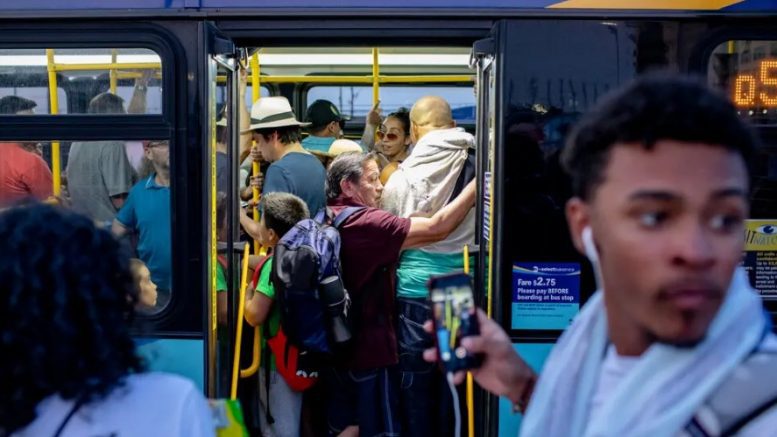I published a column two weeks ago about the necessity of a liberalism that builds and why Democrats must acknowledge their own role in making government activity difficult, notwithstanding Republican obstruction. I’d like to present a case study this week.
The New York Legislature passed a traffic congestion pricing proposal for New York City in 2019, with Governor Andrew Cuomo and Mayor Bill de Blasio’s support. The proposal seemed simple enough: starting in 2021, driving into Manhattan’s busiest regions would cost money. The funds would be utilized to improve regional public transportation.
However, some of the highways in New York City were built with federal funds, and federal law prohibits states from imposing tolls on roadways funded by the federal government. As a result, New York needs Washington’s cooperation. The Trump administration delayed its feet because it didn’t like Cuomo, de Blasio, public transportation, or congestion pricing, while the Biden administration was a willing collaborator.
And with good reason: it’s difficult to imagine a liberal aim that congestion pricing doesn’t help achieve: People who drive into Manhattan are wealthier, so it’s a progressive tax; people who take public transportation are poorer, so it helps fund public infrastructure for those who need it the most; cars emit more pollution per passenger than trains and buses, so it’s good for the environment and public health. According to one study, Stockholm’s congestion pricing model lowered air pollution by 5 to 15% while also reducing severe asthma episodes in children.
New Yorkers, on the other hand, are still waiting. Congestion pricing isn’t difficult to understand on a technical level. It does not necessitate significant new infrastructure. It’s mostly a matter of mounting sensors on poles. However, I’ve been told that the expected start date for New York’s congestion pricing program—which was authorized again in 2019—is now 2024.
During Tuesday night’s Democratic primary debate, Gov. Kathy Hochul said, “We’ve been in negotiations with the federal government that has a say on the next step.” And now they’ve thrown some more — let’s call them roadblocks — in our way, which we must conquer. So, under no circumstances, is this going to happen in the next year.
So, what’s the hold-up?
The Biden administration reached an agreement with New York in 2021. Rather than a full environmental impact statement, which now takes federal agencies 4.5 years on average to complete, New York may instead do an “environmental assessment,” which is a little more lenient.
Despite this, the procedure required 16 months of public hearings and traffic studies. In February, the Metropolitan Transportation Authority submitted a draft review. More than 400 technical questions and comments were sent to the Federal Highway Administration.
These inquiries and comments vary from technical traffic management concerns to concerns about distributional impact. The city of New York has been asked to better assess the number of low-income drivers who travel into the financial sector by vehicle, as well as the number of non-white cab drivers who may be displaced as a result of the policy.
Because of the computing power required, rerunning the models can take days each time. It’s also worth noting that New York is a wealthy, large city with numerous resources. Smaller jurisdictions with limited in-house knowledge will find these processes significantly more difficult.
I’ve heard a couple of arguments in support of the federal government’s engagement in this situation. One reason is that it is concerned that anything less than a foolproof environmental assessment will expose New York to a never-ending barrage of lawsuits.
San Francisco serves as a cautionary tale: The city adopted a plan in 2005 to provide dedicated bike lanes and parking. The city was sued under the California Environmental Quality Act, which resulted in an injunction, a 1,353-page environmental impact report (for bicycle infrastructure again), and a four-year delay. Showing that you thought about what this or that part of the policy would mean can help you win those arguments.
I don’t disagree with these concerns. However, they are an indictment of laws that make it so easy to stymie projects, not a defense of the current process. Congestion pricing levies a fee on motorists to help pay for trains.
It reduces pollutants and frees up space on the roads. Environmentally, it’s not a difficult decision. But everyone involved in the process is worried about lawsuits filed under environmental laws like the California statute or the National Environmental Policy Act (NEPA).
Janno Lieber, the M.T.A.’s executive director, told me, “We live in this highly litigious climate.” “I can’t cure that on some level.”I can’t change the fact that NEPA has become a tool for sabotaging environmental objectives.”
I want to introduce congestion pricing in the country’s largest metropolis, prove it, and demonstrate its environmental benefits. And I believe that will be a more powerful argument against environmental lawsuits than the charge that you failed to notice the five low-wage cab drivers in East New York. “
Another argument is that this will be the country’s first large congestion pricing plan, and everyone wants it to succeed. This is something I sympathize with as well. Assume you’re a seasoned Federal Highway Administration traffic engineer.
You’ve reviewed New York City’s congestion pricing plan and have some ideas for how it may be improved or how local officials could collect data that they’ve overlooked. Of course, you’ll inform them. That is your responsibility. This project is important to you, and you want it to succeed.
However, in this situation, what is sensible for an individual is irrational for the process. For the time being, all of this is just hypotheses, modeling exercises, and forecasts. Implementing congestion pricing, collecting data, and then improving it is the best way to enhance it. Delaying the program delays the time when officials will be able to learn from actual operations.
There are also more immediate ramifications. Every year the plan is postponed, the M.T.A. misses out on funds that could be used to improve New York’s squeaky buses and subways. Without congestion pricing, every year brings more cars, pollution, and asthma problems. Who is responsible for calculating the costs?
“As written, the law does not identify or weigh who benefits the environment across the board—it simply identifies who is environmentally disadvantaged,” Lieber explained. “As part of an environmental review, it has no method for weighing the benefits.” That’s what’s missing: a gauge to measure beneficial environmental outcomes. “
A third point is that, while this type of evaluation may appear strange when applied to congestion pricing, it is vital since it frequently prevents projects that are racist in design or dangerous in construction. Consider Robert Moses, who built motorways through impoverished areas.
That is correct. The question is whether it is more true than the opposite: that because construction has become so difficult, more damage is being done to the environment or to equity. The rising cost of living in blue cities, as well as the horror stories I’ve heard from people trying to create climate infrastructure, make me doubt that the balance we’ve reached is the right one.
Under Secretary Pete Buttigieg’s leadership, I believe the Department of Transportation truly understands that climate change is an existential issue. I believe it honestly feels that equity is the most important consideration.
I believe it honestly believes that public transportation is a public good. I don’t believe it really believes that the incapacity of Democrats to create infrastructure swiftly and experiment with policy openly jeopardizes all of those aims, and much more.
Alternatively, if it believes that it has not matched its process with its principles, The Federal Highway Administration has turned into a congestion pricing ombudsman, rather than a proponent of a project that New York voters are well-equipped to assess. Elections, rather than technical evaluations, are usually the most effective means of ensuring accountability.
And believe me when I say that I haven’t chosen the most divisive program or the most inefficient approach. Quite the reverse, in fact. Congestion pricing is an excellent case study since it is a simple policy that has the explicit, if not ardent, support of all important decision makers.
Rather than spending money, it generates revenue. It is not necessary to construct new tunnels, dam rivers, or construct a train track through a city. This one is simple in terms of big climate policy. Despite this, it has proven to be extremely difficult.
I’m starting to wonder if the recent craze for simple money-transfer schemes reflects a silent lowering of expectations. I’ve pushed for similar programs myself, and I sincerely want to see the child tax credit increase repeated. We’re confident that the government will send checks. We’re not sure what it’ll be able to construct.
I recall asking folks who were assisting in the drafting of the bipartisan infrastructure pact what lessons they had learned from the 2009 stimulus package. High-speed rail, a smart electrical grid, and a nationwide system for digital medical records were all part of the bill’s legacy-defining, headline-grabbing initiatives.
The more ambitious efforts, on the other hand, produced disappointing results. So, the 2021 infrastructure bill gave priority to projects that the bill’s authors were sure could be finished, such as infrastructure repairs but not just those.
To be honest, Build Back Better envisioned a far more ambitious collection of climate projects. And I’d like to see those come to an end. But, if they pass, I’d like to see them built quickly. That is not what our current government is designed to do.





